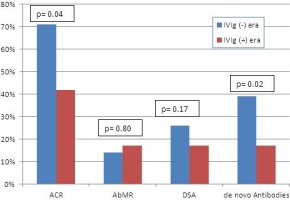Donor Selection and Prophylactic IVIg for Induction Immunosuppression Improves Outcomes for HIV+ Kidney Transplant Recipients (HIV+ Tx)
1Dept of Pharmacy, Hahnemann University Hospital, Philadelphia
2Dept of Surgery, Drexel University College of Medicine, Philadelphia
3Dept of Medicine, Drexel University College of Medicine, Philadelphia, PA.
Meeting: 2015 American Transplant Congress
Abstract number: A98
Session Information
Session Name: Poster Session A: Kidney Antibody Mediated Rejection
Session Type: Poster Session
Date: Saturday, May 2, 2015
Session Time: 5:30pm-7:30pm
 Presentation Time: 5:30pm-7:30pm
Presentation Time: 5:30pm-7:30pm
Location: Exhibit Hall E
HIV+ Tx recipients are noted to have higher rates of allorecognition through cellular and humoral mediated pathways. Since 2010, our program instituted IVIg use as part of the induction therapy in HIV+ Tx to minimize humoral allorecognition.
Methods: Since protocol initiation, all HIV+ Tx have received IVIg as part of the induction immunosuppression. The IVIg (+) era was compared to the previous IVIg (-) era. The incidence of de novo allo-Ab and AbMR was compared between the two groups.
Results: 105 HIV+ Tx, 93 IVIg (-) vs. 12 IVIg (+) recipients, received basiliximab + calcineurin-inhibitor based immunosuppression. The second era received 0.3 – 0.5 g/kg IVIg at the time of Tx. Demographics were similar between both eras (Table 1), with the exception of certain donor parameters, including lower donor terminal serum creatinine and less CVA among donors in IVIg (+) HIV+ Tx.
| Table 1 | IVIg (-) | IVIg (+) | p-Value |
| Recipient Age | 48 ± 8 | 50 ± 8 | 0.4 |
| African American | 88% | 50% | 0.01 |
| Male | 87% | 92% | 0.65 |
| Incidence of Delayed Graft Function | 60% | 50% | 0.50 |
| Donor Age | 39 ± 15 | 37 ± 11 | 0.04 |
| Donor Terminal Creatinine | 1.5 +± 1.2 | 0.9 ± 0.3 | 0.06 |

De novo antibody production was decreased among the IVIg (+) group (de novo non-specific antibodies post-transplant 17% vs. 39%, p= 0.02). However this did not translate to a decrease in de novo DSA production (16% in both groups, p = 0.37). The rates of antibody mediated rejection (AbMR) was similar between the 2 groups (17% vs. 14%, p = 0.80); albeit the time to the development of AbMR was increased (median time to AbMR 430 days vs. 48 days). Additionally, the second era had improved renal function at 1 year (eGFR 54 + 16 mL/min vs. 36 + 29 mL/min, p = 0.07) and less cumulative ACR (42% vs. 71%, p = 0.04).
Conclusions: We postulate that strategic donor selection and IVIg as part of induction may lead to improved kidney allograft function and lower de novo Ab production.
To cite this abstract in AMA style:
Malat G, Panarey L, Sharma A, Ranganna K, Reich D, Xiao G, Doyle A. Donor Selection and Prophylactic IVIg for Induction Immunosuppression Improves Outcomes for HIV+ Kidney Transplant Recipients (HIV+ Tx) [abstract]. Am J Transplant. 2015; 15 (suppl 3). https://atcmeetingabstracts.com/abstract/donor-selection-and-prophylactic-ivig-for-induction-immunosuppression-improves-outcomes-for-hiv-kidney-transplant-recipients-hiv-tx/. Accessed December 15, 2025.« Back to 2015 American Transplant Congress
